Michelle Meyer: In Her Own Words
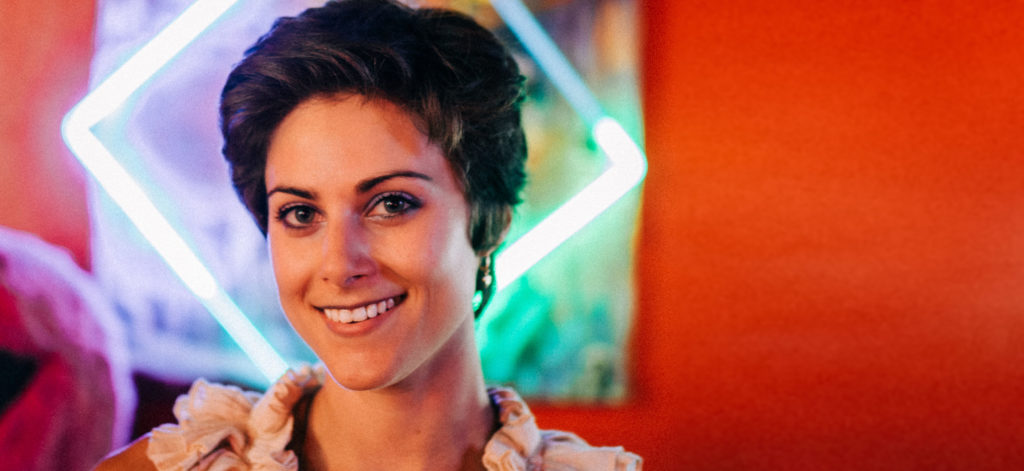
Dec, 15, 2020
ArtistsCommunityPhxArtist Spotlight
Michelle Meyer: In Her Own Words
Originally from Illinois, Phoenix-based artist Michelle Meyer, also known as Meesh, has been on a creative and entrepreneurial journey for nearly a decade now. The goal? To build a dynamic concept and community that can sustain not only her artistic ambitions, but those of her fellow artists in the Valley of the Sun.
Located on Grand Avenue, Michelle’s brainchild, Snood City, offers just that type of collective creative space where art friends become family, all amidst the light of hand-twisted neon forms. Michelle and her fellow Snood City Residents “are not here to do what has been done before”—and it shows.
We spoke with the artist, who studied graphic design and sculpture at Arizona State University, to learn the story behind Snood City, Snoodmen, and her ongoing mission to encourage interaction and growth through art.
Here’s Michelle Meyer, in her own words.
“[F]or me, art is not so much about the object as it is the exchange of ideas and perspectives that the object induces.”
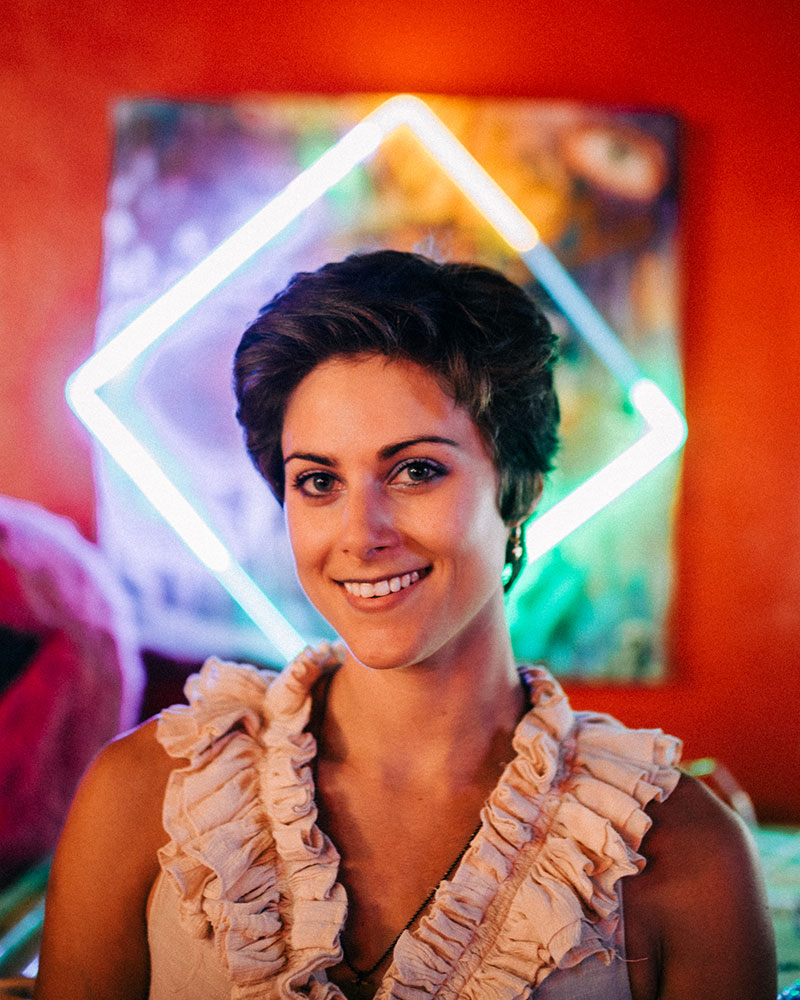
Michelle Meyer, First Friday at Snood City Neon, September 2019. Photo by Matthew Benton.
PhxArt: Tell us about your childhood. When did you know you wanted to be an artist, and what motivates you to keep creating?
Michelle Meyer: I was born and raised on an organic herb farm in the northwest suburbs of Chicago. As an only child, I spent a lot of time outside on my own, with my dogs, on excursions through the woods of the property I grew up on.
I am pretty sure my self-actualization that I was going to be a creative in the world came at a young age, maybe 6 or so. My parents had met working as chefs in downtown Chicago, and my inspiration came through arts and crafts with my mother, who is creatively inclined, while my business sense stems from my father, a go-getter entrepreneur. My godmother was also an extremely talented seamstress, and I learned to sew from her. I have memories of my first art projects, where I used Sculpey Clay to make figurines, beads, and trinkets that I would then play with. Dress up was also a big part of my childhood. I liked building worlds and storylines and immersing myself in the characters.
My biggest inspiration today is embracing the wonders of the world and keeping curiosity alive. I strive to create things that make people remember that we all have a spark inside of us. The world can be rough and tumble but it can also be beautiful. It’s all about how you roll with it. I aim for my work to inspire things within others. Snood City is the ultimate emulation of that.
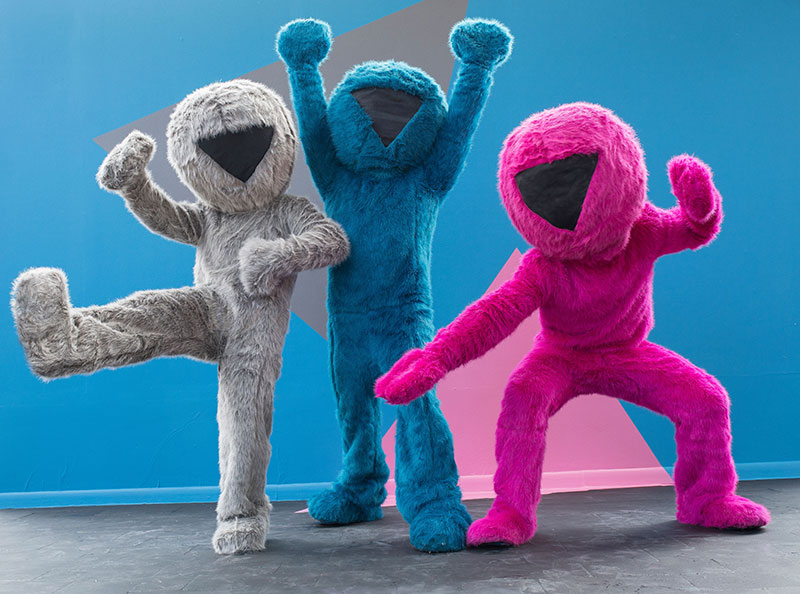
Michelle Meyer, Snood Rangers, 2018. Snood. Photo by Chris Loomis.
PhxArt: Tell us about Snood City. What’s its mission? What does it strive to be?
Meyer: Snood City was founded as the realm for Snoodmen to champion. Snoodmen is a fuzzy, gesture-based creature that uses only body language and movement as communication. They have a lollipop head and an upside-down triangle face and are dedicated to instigating shenanigans and freedom of expression.
The original Snoodmen is Pink, which debuted in December 2013 as part of the first installation I did while I was at Arizona State University in the sculpture department. I originally started Snoodmen as an LLC just after I got out of school as a way to protect the idea before I really knew about copyright and trademarks. Part of this process was staking my claim on all the available media channels at the time. When I got to the website, snoodmen.com was already taken and didn’t quite seem right, as the concept went far beyond the character. I wanted to create a platform meant to host more than just Snoodmen. I wanted the entity to have the capacity to be an entire world that could support different media and ventures.
Snood City was a thought that came up in my mind many times and had a nice ring to it. Snoodmen came to rise through a fellowship, so I wanted to create something with the capacity to extend beyond an individual and support a community, like the one that allowed Snoodmen to come into existence.
In its current state, Snood City, with Snoodmen as its mascot, functions as an arts collective, production house, neon shop, and entrepreneurial incubator. The motto of Snoodmen and the residents of Snood City is, “Stay unconventional.” It is a platform for interactivity and growth where we honor the life force within us all and spark it in those who may have forgotten they have it.
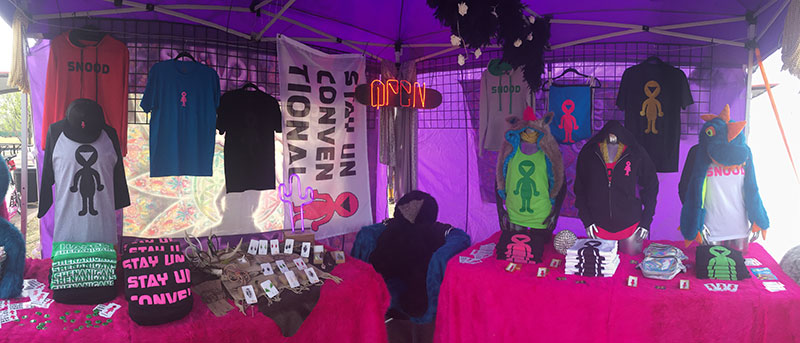
Snood Booth, Pot of Gold Music Festival, March 2019. Courtesy of the artist.
PhxArt: What are the media you prefer to work in?
Meyer: As time goes on, I am realizing that my preferred media might just be found objects. There is already so much material in the world, and sometimes it just needs a little attention. It’s that whole concept of “one’s trash is another’s treasure.”
I like to work in the sewing and wearable arts, which has been a big part of creating Snood City, from the Snood suits to plushies, headwear, and logo tees. I also enjoy working in metal. The instant gratification of welding is exciting.
With a background in graphic design, I have a high proficiency in Adobe Illustrator and like to create work through that program. I really like how I can export my files to other machinery, like a CNC machine or laser cutter. I love this process because it allows me to bring something from 2D into 3D.
I also like working with light. Light is such a great medium because it is all encompassing. It is frequency, vibration, and, in essence, life. Light is the way we are able to see, so it is fitting to use it to tell the stories of the world. It can be bent, as with neon, or used as a compliment to illuminate form.
PhxArt: Who are your greatest artistic influences?
Meyer: M.C. Escher because he creates imagery that blends and extends beyond what is perceived to be natural, and yet it all somehow fits together seamlessly. You can just roll into each section effortlessly, and then you step back and marvel at the complexities.
Lisa Frank had a big impact on me as a young child, with the pop-y bright colors and bold lines. Then there were the band tees and skater/snowboarder gear of my teenage years. The patterns, colors, and graphics really resonated with me and are what led me to begin in graphic design. I wanted to create those wearable, functional items that people were living in—art off the wall—because for me, art is not so much about the object as it is the exchange of ideas and perspectives that the object induces.
Op art was also influential for me because there is always more than meets the eye. Each person sees an Op artwork differently based on who they are and where they are standing in the room looking at it.
Erté is one of my favorite artists as well. His illustrations are timeless and tell such a beautiful story. They are so clean, yet elegant and rich with imagery.
The fashion art of Guo Pei and Thierry Mugler is extremely inspiring. The theatrics, grandeur, and iconic aesthetic of their work is incredible, bringing characters to life through wearable art. In my personal work, I am extremely drawn to exhibit in that format because I see fashion as one of the highest forms of art. It is concept, craft, design, presentation, and function all wrapped up into one. Art is a living and breathing concept, and I like to display it as such.
“Master Your Monster” Grand Avenue Festival 2019. Video by Marc Silverstein.
PhxArt: What’s a project you’re currently working on or have recently completed?
Meyer: The biggest current work has been team building in this time of isolation. At Snood City, we often ask ourselves: How do we all work together, how do we stay safe, and how do we respect what is going on in the world outside of our bubble? Since then, we have moved forward and are working on a 10′ sculpture with artist Sean T French. It’s a giant, glass-finned siren suspended in a 10′ ring that will be on display at his show at The Icehouse, opening January 1.
My most recently completed series, though, is the Snoodmen Series, which was finished in August 2020.
As I mentioned earlier, Pink, the original Snoodmen, premiered during my semester finale show in 2013 at The Icehouse in downtown Phoenix. There have been subsequent renditions of the suit, dialing in the pattern to get the proportions right. The current version (5.0) of Pink Snood has informed all of the following versions, and once I got the pattern right, I began to build a Snood suit from each of the original colors: pink, blue, grey, and black. In my concept exploration while in school, I created a plush series of Snood Dudes using the original colors in a permutation set, for example a blue Snood with a pink face, a blue Snood with a black face, a blue Snood with a grey face, and so, on with every original color represented in each variation.
Up until recently, it had been awhile since the last time I had made a Snood suit; I completed Grey Snood in December 2018. People would always ask, “What color is next?” but I knew that I had to make one from each of the original colors before I moved on to the rest of the rainbow.
Then enter 2020 and the explosion of the second half of the modern civil rights movement. Being in the middle of downtown Phoenix, just blocks from the Capitol, we were in the heart of it when the protests and demonstrations came to rise. Many of us got very involved, and Snood City became a sanctuary for people to gather before and a safe place to come back to and discuss our experiences and views on what was going on out there.
During one night that was especially intense, it dawned on me that this was a special moment in our history. It was very serendipitous that at this juncture, black was the final color to the Snoodmen set I was working on. The concept that had come into the world so long ago had found its time to make itself complete.
Over the course of months, I began building the suit. I am a believer that energy is imbued and transmitted through our actions and can be embedded in objects, and the spirit of accountability, unity, and resilience is what Black Snood represents. Shenanigans come in many forms, and though this work was created on more of a somber note, it is another testament to the power of art and the messages that it is able to transmit. Black Snood is a representation of the times—what has come to the surface and what we as a society need to recognize and address because it has an impact on all of us, directly or indirectly. There is no turning a blind eye to the work that must be done.
In addition to this, our collective recently completed a voting awareness mural in partnership with NextGen America called The Future is Ours. I believe an artist’s role is more than to create visually pleasing things. We are here to tell the stories of our times. It is very important to me that Snood City’s messaging and culture go beyond the fluff and aesthetically pleasing. Through our work and installations, we remind people that our connection to one another is deep, as we are all made of the same stuff—it’s just the outside that is different. And once you realize that, you realize the power we possess as a whole and as unique individuals.
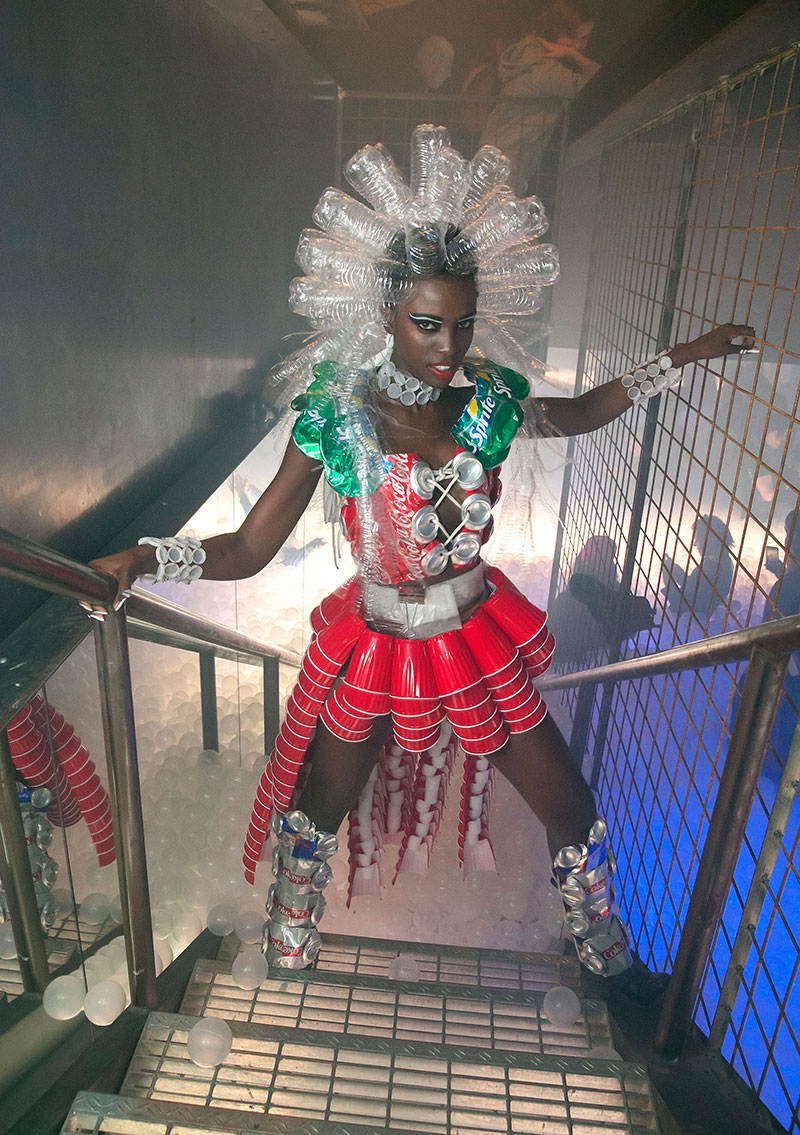
Michelle Meyer, Plastic Priestess, 2018. Upcycled trash objects—water bottles, pop cans, and solo cups. Photo by Chris Loomis.
PhxArt: What can our community expect to see next from you and Snood City?
Meyer: Along with the rest of the world, we are in the midst of a significant gear shift. As for what is specifically next, it is tough to pinpoint.
We hope to bring back our monthly First Friday events at our studio on Grand Avenue, but the timeline is still uncertain given the current circumstances. A majority of what we do is interactive, and we want to maintain our civic responsibility.
There is so much building happening in the downtown sector that it would be great to get some neon or permanent installations in those spaces to bring uniqueness to the cookie-cutter towers that are going up left and right.
Monumental and public art is also something we’re interested in. Especially with the social-distancing measures in place, it seems now is the time, more than ever, when public art can be experienced by all, near or far. The world needs to be reminded of the beauty of life and that we are just one piece of the puzzle, and that type of art does that. It is a reality check posed in the language of form—you realize how small you are but that you are still essential because if you were not there to view or interact with it, the art (like the world) would not exist.
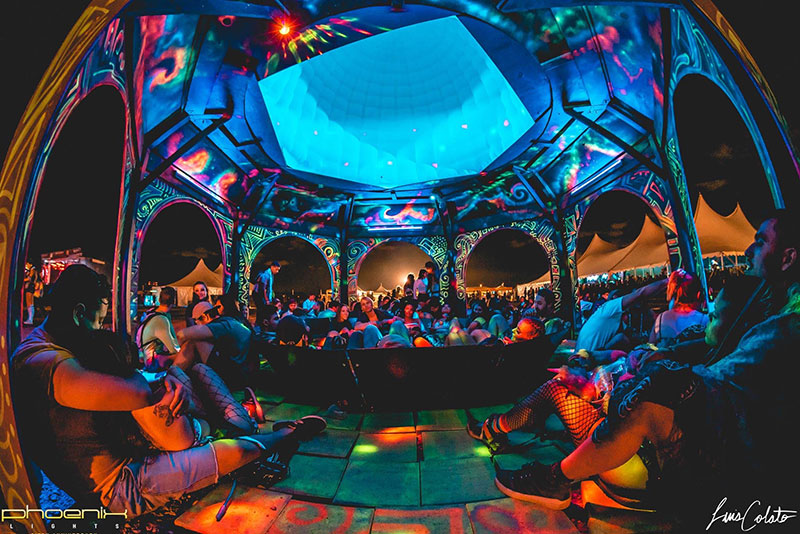
Michelle Meyer, Octagon Lounge—Phoenix Lights Music Festival 2019. Plywood, UV light, and inflatable dome. Photo by Luis Colato.
PhxArt: What’s some advice you’d give to creatives just starting their career or those who are thinking about starting their own art-industry ventures?
Meyer: Don’t be afraid to try new things, make friends with uncertainty, and remember the balance. If you are building a business into your art practice, there will come a time when sacrifices must be made in the realm of freedom or fun—like during business planning or account management—but it is all part of the bigger picture. And in the interest of creating a sustainable practice, those things are essential. If you do your due diligence, it will pay off tenfold in the future. You will be able to transcend outside of the art-realm bubble because by learning how to do these things, you are connecting yourself to the rest of the world and giving yourself another avenue to get out there. This does not mean you have to conform or sell out. Stay true to yourself and your mission, but take in the lessons and use them to build something better and stronger.
Also remember that your network is your greatest asset. Find inspiring people—those you admire and want to emulate—and make yourself present. Go out and experience new opportunities, and make sure you have solid people you can count on. Make sure your vision is clear, as there will be many trials and tribulations. People will question you, you will question yourself, but having your vision solid—and knowing that the path forward will not always be straight—will allow you to move through the tough situations and continue on to materialize your goals.
See more
To discover more work by Michelle Meyer and Snood City, visit www.snoodcity.com or follow @snood_city on Instagram. For questions or custom inquiries, email snoodmen@gmail.com.
#CreativeQuarantine
We’re curious how creatives are navigating the time of coronavirus. Michelle Meyer shares what’s giving her life as a creative during quarantine.
Meyer: At the beginning of quarantine, I was reading a lot of newspapers, and that was depressing but informative. It’s important to know what’s going on in the world to operate in it and to formulate your own educated opinion.
At Snood City, we’ve been doing a lot of cleaning and re-organizing. Being sculptural, immersive artists means that everything is art supplies, so there’s a mass accumulation of stuff. COVID has been cleansing in a lot of ways, physically and emotionally, bringing the muck to the surface so it can be dealt with. Also, in going through all of the materials, the history of the work and its evolution can be seen, and it’s freeing to let go of past work or materials and make room for new ones. It’s equally as freeing to discover materials that have been hidden away and feel inspired to create something new with them.
The greatest silver lining of COVID-19, though, has been the perspective that it has given everyone. We are all asking ourselves: Are you happy with yourself, your home, your life? Fortunately, my answer is mostly yes, largely due to the incredible community that Snood City is. Day one of the pandemic implosion, we had friends and fellow artists reaching out to let us know that if we needed anything, they were there. It was and remains a beautiful thing—to know that the network/community you have poured your life into has your back when it counts, in sickness and in health. It’s worth its weight in gold, priceless really. We are a ride-or-die crew, and it is a point of pride for the collective. It’s not just about you and your art as a singular entity—it really is a city, and we all have our role to help it thrive and keep ourselves accountable. What is good for one is good for all, and we celebrate that.
Categories
What can we help you find?
Need further assistance?
Please call Visitor Services at 602.257.1880 or email